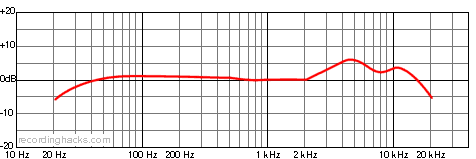 Blue Microphones Mouse
Blue Microphones Mouse
Cardioid Condenser Microphone
The Mouse is a cardioid condenser which employs a hand-built, single-membrane, large diaphragm (34mm) capsule. The diaphragm is a 6-micron mylar film, sputtered with a mixture of pure gold and aluminum, tensioned to a brass backplate.
Blue Microphones
The Mouse utilizes a tunable capsule, similar in architecture to that used in the Blueberry. It is not the same as any of the B-series capsules. Its tuning is exclusive to the Mouse.
This is emphatically not a flat, neutral, uncolored mic.
Recording Magazine
Enclosed and shock-mounted within a rotating spherical grille, the capsule can be positioned and adjusted easily. It has been voiced with low-frequency sources in mind.
The Mouse was originally available either with or without an output transformer. The transformer in question was a 1:1 design. The two models are distinguished by body color:
| Model | Color |
| Transformer-coupled | Matte black |
| Transformerless | Royal blue |
The transformerless version was available only in limited quantities, and was discontinued around 2002.
Blue described no difference in sound or application between the two versions of the microphone.
Skipper Wise, 2004
We designed [the Mouse] for broadcast. It was designed to have that edgier-type sound to cut through. It doesn’t have the silkiness or the top end of our Blueberry or maybe the Dragonfly. It is meant for speech-oriented [material].
Recording Magazine
I was ready to give the Mouse a B-minus on guitar… The first try had been at my standard distance for recording this guitar, 8''. Following a conversation with Skipper Wise of BLUE, in which he indicated that the Mouse has more “reach” than most microphones, I decided to try the mic at 12'' instead.
Jackpot! It was as if the guitar shifted into focus. The pick noise was no longer excessive or annoying, the body returned and the tonal balance was just right. In fact, this guitar has seldom sounded better — certainly not on solid-state gear.
Perhaps the secret of the Mouse, at least as an instrument mic, is to give it some air. Don’t crowd it. If the room allows, let the sound develop and swap around a bit. More than most, this mic has its own way of working and you’ll need to experiment a bit to get the best out of it.
The Blue Mouse, like several of Blue’s early products, was the subject of an intellectual property dispute in 2006, when the original manufacturer, SIA Scruples/Violet Design, attempted to register a lookalike microphone with the EU’s “Office for the Harmonization of the Internal Markets” — essentially the EU’s trademark office. The OHIM called Scruples’ registration invalid, awarding the IP rights to Martin Saulespurens of BLUE. For a time, this mic was known as the Violet JZ-2 or JZ2.
The Blue Microphones Mouse is also known as: JZ2, JZ-2.
The mic was released in 1998.
Specifications
| Frequency Response - CardioidClick Graph to Compare! |
|---|
 |
| Pickup Patterns | Pads & Filters |
|---|---|
|
Cardioid
(21 mV/Pa; 20 - 20,000 Hz) |
|
| Capsule Dimensions | Impedance | SPL/Noise |
|---|---|---|
| Capsule diameter: 34mm Diaphragm gauge: 6 microns |
150 Ohms (Low) | Max SPL: 134 dB Self-noise: 8.0 dB(A) |
| Weight | Length | Max Diameter | Interface(s) |
|---|---|---|---|
| 980g (34.57oz) | 165mm (6.50'') | 65mm (2.56'') |
|
| Power Specifications |
|---|
|
Did we get anything wrong on this page? Please let us know!




